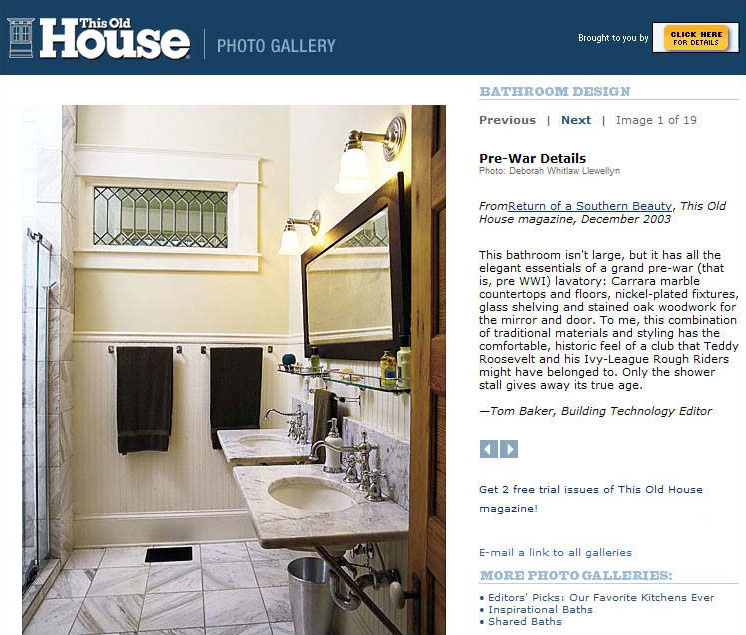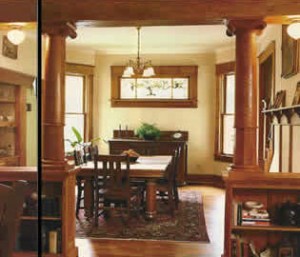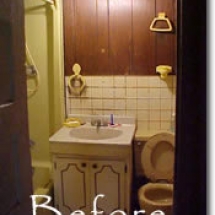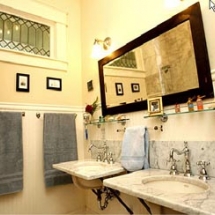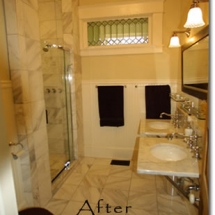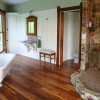
This Old House Magazine – Editors Picks: Our Best Bathrooms Ever
Fall 2006
By Laura Fisher Kaiser
Photographs by Deborah Whitlaw Llewellyn
Styled by Brian Carter
Kara has enjoyed being a “go-to” pro for _This Old House Magazine_ for several years now. But when the magazine chose a bathroom that Kara had renovated soup to nuts as one of their five “Best Bathrooms Ever,” –well, it doesn’t get much better than that. The timeless qualities of this small bathroom are why it was selected as a “Best Bathroom.” The classic white marble floors, sinks, dark wood antique mirror, glass shelves, and chrome fixtures gives it “the comfortable historic feel of a club that Teddy Roosevelt and his Ivy League Rough Riders might have belonged to.”
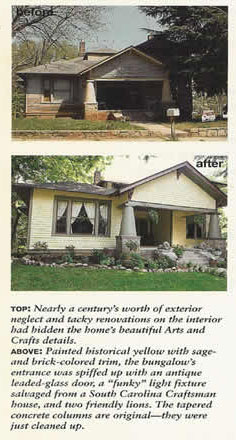 No strangers to monster project, Kara O’Brien and Paula Rose have been hobbyist house restorers for seven years, turning fixer-uppers into handsome homes and “flipping” them. But when they took on a rundown bungalow in Kirkwood, a section of Atlanta experiencing a revival, they knew no amount of resale profit could make them give it up.
No strangers to monster project, Kara O’Brien and Paula Rose have been hobbyist house restorers for seven years, turning fixer-uppers into handsome homes and “flipping” them. But when they took on a rundown bungalow in Kirkwood, a section of Atlanta experiencing a revival, they knew no amount of resale profit could make them give it up.
For five years they had walked past the house in their tree-lined neighborhood, thinking it had potential. So when the property went on the market, they took a peek.
Built in 1912, the 4,000 square-foot Arts and Crafts home had five bedrooms-three downstairs and two upstairs. And although it was filthy and neglected, details like five-panel doors and handsome period hardware were still in evidence. Off a central foyer/living room, the smoking parlor contained one of a pair of stained-glass windows in a tulip pattern (the other was MIA), and in the dining room a triple bay contained a larger stained-glass window with a wisterialike motif. “When I walked into the dining room, I didn’t need to go any farther. Despite all the grunge, the sun came through the ‘wisteria window’ and I was hooked,” Kara recalls.
Indeed, every room needed attention. For starters, the wisteria window had been pierced by a bullet sometime in its life. Warped fake wood paneling hugged nearly every wall. Garish orange paint covered the built-in sideboard, plate rack, and other woodwork in the dining room. A somewhat more acceptable color of paint was flaking off the exterior, and some of the clapboards were rotting beneath it. Neither the electrical nor plumbing had been updated in 40 years. Oddly, the place had acquired two kitchens, back-to-back, with brickwork encasing even the cabinets. More brickwork covered a wall in the living room. “There was a mason living here, and I think he must have had a lot of time on his hands,” Kara says.
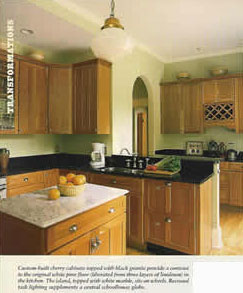 Unfazed, they snagged the place for $180,000 and began undoing the damage. Seven dumpsters later, Paula, a marketing analyst and self-taught designer, drew up the plans that would bring the home back to its 1912 glory. “Our goal was to make this house old again,” says Kara, a writer. “And the more we worked on it, the more the house revealed.” Not that this was always good news.
Unfazed, they snagged the place for $180,000 and began undoing the damage. Seven dumpsters later, Paula, a marketing analyst and self-taught designer, drew up the plans that would bring the home back to its 1912 glory. “Our goal was to make this house old again,” says Kara, a writer. “And the more we worked on it, the more the house revealed.” Not that this was always good news.
Return To Glory
When they peeled off the fake paneling they discovered not only a bunch of 1970s rock posters still plastered to the walls but the reason someone had covered them up: The walls were in terrible shape from water damage. Further evidence that the roof was shot came one day when a cloudburst produced “interior waterfalls all over the house.” In the basement, a 20-inch wide beam was eaten through by termites; they replaced it with several laminated veneer lumber (LVL) beams. What’s more, the house was under built-“It was a miracle that the upstairs hadn’t collapsed,” says Kara. So they beefed up the ceiling joist with more LVL beams
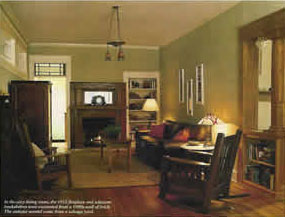 Yet they found plenty to inspire them. A lot of stripper and sand paper revealed beautiful heart-pine columns in the dining room. Entombedbehind three courses of brick in the living room were a full-size fireplace and a built-in bookcase. In another happy surprise, the mantel in the smoking parlor (now used as a study) turned out to be a hand-carved delight with an Arts and Crafts tile surround. As Kara and Paula worked their way through the house, they uncovered boarded-up windows in the foyer, tore out acoustic ceiling tiles in some of the rooms to reveal the old 11-foot ceilings, stripped paint-covered heart-pine doors, and took layers of paint and years of tarnish off original brass window hardware.
Yet they found plenty to inspire them. A lot of stripper and sand paper revealed beautiful heart-pine columns in the dining room. Entombedbehind three courses of brick in the living room were a full-size fireplace and a built-in bookcase. In another happy surprise, the mantel in the smoking parlor (now used as a study) turned out to be a hand-carved delight with an Arts and Crafts tile surround. As Kara and Paula worked their way through the house, they uncovered boarded-up windows in the foyer, tore out acoustic ceiling tiles in some of the rooms to reveal the old 11-foot ceilings, stripped paint-covered heart-pine doors, and took layers of paint and years of tarnish off original brass window hardware.
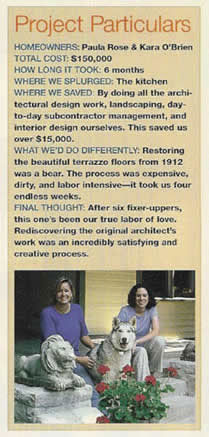 And then there were the stained-glass windows. Local glass artisan Tom Marr patched the bullet hole in the wisteria panel on-site. He then took the tulip-patterned window out of the smoking parlor to create its twin in his shop. Marr also redid the caming on several leaded-glass windows and a newly installed leaded-glass front door that came from a historic Philadelphia house.
And then there were the stained-glass windows. Local glass artisan Tom Marr patched the bullet hole in the wisteria panel on-site. He then took the tulip-patterned window out of the smoking parlor to create its twin in his shop. Marr also redid the caming on several leaded-glass windows and a newly installed leaded-glass front door that came from a historic Philadelphia house.
Grand Finale
Intrepid antiques hunters, Kara and Paula found in a salvage shop, the perfect pair of 100-year old oak columns to divide the new master bedroom suite-comprising a former sunroom and downstairs bedroom-into separate sleeping and sitting areas. Their carpenter, Atlanta-based Patrick North, added built-in bookcases underneath, which echo a similar feature in the living room.
 Scouting architectural gems was a breeze, however, compared with their quest to restore the terrazzo floors in the first-floor guest bathroom and on the porch. They set about mixing bags of Portland cement and marble chips, only to discover they needed not four bags of chips but 35. After weeks of polishing with a diamond-disc grinder-which rents for $150 a day-they had beautiful honed-finish floors, but the newly painted house was covered in a fine gray dust.
Scouting architectural gems was a breeze, however, compared with their quest to restore the terrazzo floors in the first-floor guest bathroom and on the porch. They set about mixing bags of Portland cement and marble chips, only to discover they needed not four bags of chips but 35. After weeks of polishing with a diamond-disc grinder-which rents for $150 a day-they had beautiful honed-finish floors, but the newly painted house was covered in a fine gray dust.
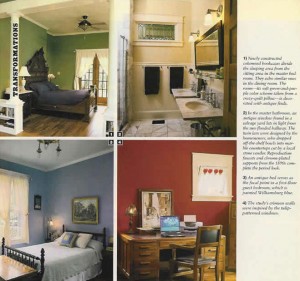 The room that changed the most dramatically was the kitchen, which mixes modern and vintage elements. They chose Mission-style cabinets in a natural cherry to contrast with black granite counters. And they splurged on a cherry-paneled double-drawer dishwasher because, Kara says, the idea that you could “wash the dishes on top and store them in the bottom appealed to the lazy part of us.”
The room that changed the most dramatically was the kitchen, which mixes modern and vintage elements. They chose Mission-style cabinets in a natural cherry to contrast with black granite counters. And they splurged on a cherry-paneled double-drawer dishwasher because, Kara says, the idea that you could “wash the dishes on top and store them in the bottom appealed to the lazy part of us.”
They still shake their heads over the unsolved mysteries like the rampant brickwork in the kitchen and living room, and the bullet hole in the stained-glass window. There were plenty of revelations, including one they didn’t expect: After starting to plant grapes along the property’s wrought-iron fence, Kara realized that the “wisteria” window actually depicts a grapevine. As with so much of the house, it was not quite what it had seemed-but maybe even more charming.
“Shrine to Marble” Bath
This bathroom needed to be gutted: the nearly 11 foot ceilings had been lowered dramatically and the bath was sporting dark, fake wood paneling and cheap 1970’s fixtures. We expanded the space with new framing, brought in marble tiles and built a walk-in shower, running the marble to the ceiling. We designed he sinks out of Venetino marble, using matching old 1800-era chrome brackets to hang them from the wall. A leaded glass transom window, antique lighting, glass towel bars, and antique oak mirror were added to complete the period ambience.
